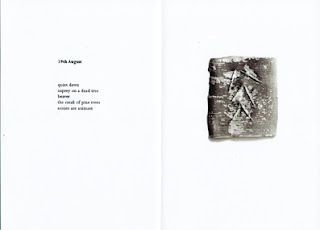Today I went to the
Small Publishers Fair, an annual event which I based posts on
last year and
the year before. Among today's purchases was a Chris Drury book,
Algonquin, on sale at Peter Foolen's stall. Peter publishes prints and books by some of this site's favourite landscape artists - Hamish Fulton, Thomas A. Clark, Roger Ackling. He has his own
blog - recent posts feature Richard Long's huge
Riverlines for the entrance of Norman Foster's Hearst Tower, and Ian Hamilton Finlay's
exhibition at the David Nolan Gallery (I like his statement in camouflage green: "Camouflage is the last form of classical landscape painting. It represents not
this tree or
that field but fields and trees").
Chris Drury, Algonquin, 2008
The Chris Drury book, jointly designed by Peter Foolen, is described on (and can be ordered from) the artist's
website. Based on a canoeing trip in Algonquin Provincial Park, Ontario, it was inspired by the Algonquin language 'which had its beginnings as bite marks on bark.’ 'I experimented to find out how you could make bite marks on Birch bark and found that if you fold the bark, bite it and then unfold, you create a line, which must have formed the basis of a cuneiform writing. For each of the seven days I collected one piece of Birch bark and kept a diary of things seen, heard, experienced and sensed. The result is this small publication.'
The natural 'writing' on these pieces of bark might look asemic in isolation (I'm thinking of the many interesting examples of asemic writing collected on
The New Post-Literate site), but each one seems to take on meaning from its accompanying text, which could be taken for translations. So, for example, the 'liquid wave patterns' seen from the canoe on 18th August are echoed in four wave-like marks in the bark. The shape of the bark itself also reflects the pattern of the text - a long strip follows a similarly shaped column of short descriptive words for 17th August - and the 'silver grey' first light of August 16th is repeated in the colouring of the bark itself.

3 comments:
Very interesting! I'd never heard of asemic writing, but of course I have done it. I guess everyone has.
Great act of imagination on Drury's part to take the etymology of Algonquin as literally as he does. Makes me think of a sculptor who carved big blocks of chocolate and butter with her teeth.
It was great to come home to Midwestern U.S. poet John Martone who was featured in the asemic writing blog. It matters a lot to me how nearby a poet is. It's the commonality of a shared landscape. With Martone it seems I've spent my life inside his poems. Nemerov does that to me as well, there was a time when we both walked the same neighborhood sidewalks. Because of the shared landscape it turns out that the poet is writing about me.
Thanks for the comment. Prior to reading the Chris Drury book I probably would have associated the word 'Algonquin' with Dorothy Parker...
Ah. I spent summers there, you see.
Post a Comment